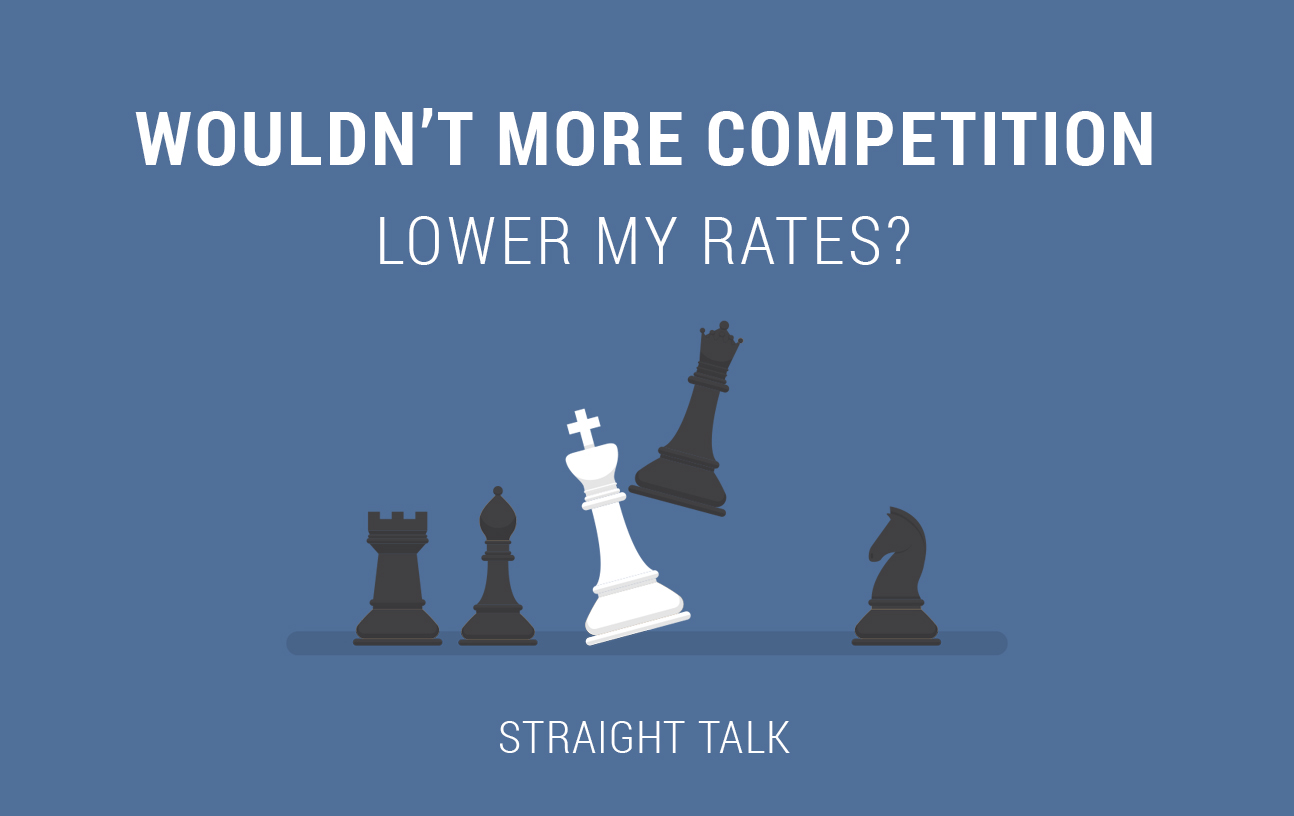A few weeks ago, I was invited to speak at a large meeting of employers who offer health insurance (and lots of other benefits) to their employees. All of them said they are struggling with continuing to pay for those benefits. As we entered the Q&A portion of the program, a very nice lady about halfway back stood up and fired a broadside at me:
“So, how about some more competition in health insurance in this state?! Can’t we get the prices down with more competition?”
Lovely! I thanked her for that strong and insightful question and then proceeded to answer it exactly the same way I’m going to lay it out for you here, as I’ll bet many of you have thought/heard/wondered the same thing. It’s a long answer, but I think you’ll find it worth the journey.
You see, the type of competition is critical to successfully answering this question. Confused? Fear not, we don’t call this Straight Talk for nothing.
Where Do All Those Premium Dollars Go?
To understand how more insurance competition affects health insurance rates, let’s look at how money flows through a health insurance company. At the end of the day, after you count federal medical loss ratio restrictions and other pressures, insurance company income statements all look pretty similar.
Let’s use our 2016 financials as an example:

What you see here is how Blue Cross spent more than $3.2 billion in premiums the good people of Louisiana trusted us with during 2016. That’s a lot of money, and since you, our members, own us, you deserve to see exactly what we did with it.
Between the money that bought inpatient hospital care (39 percent), physicians/outpatient care (25 percent), drugs (21 percent), and the fees we pay to healthcare.gov (almost 4 percent), 89 percent of all the premium dollars paid for direct medical care and care support. Only about 11 percent of the premium money we took in paid for non-medical stuff.
So, let’s think about competition coming to town. Let’s say a real, web-based health insurance disruptor comes in and does everything the state and federal government requires a Louisiana insurance company to do, including supporting their clients for half what Blue Cross spent last year on administration (not really possible, but let’s imagine). That would potentially lower rates 3.4 percent. Go ahead and cut out the broker commissions and broker support, too, for our example. Now, in our made-up world, we can save 7 percent on rates! We are getting somewhere, right?
Hold on – the insurance company still has to pay for all that healthcare its customers are going to need. And since medical inflation is many times higher than regular inflation, how long before it replaces that magical 7 percent savings?
Less than one year.
Less than a year, because we ignored the real elephant in the room, the actual cost of healthcare, which consumed 89 percent of our premiums. Turns out competitive disruption only bought us a few months of relief.
Building a Bridge
Why does this matter so much? To illustrate, let’s look at a non-healthcare example.
Imagine that you are a general contractor who has been asked to bid on the brand new, Baton Rouge I-10 bridge over the Mississippi River! So exciting! Everyone is going to be your best friend because you’ll solve their traffic woes!
“In 2016, 89 percent of Blue Cross’ premium intake went out to these subs, and all carriers basically use the same ones. So … how do we build our bridge?”
You know there are four other firms bidding, so you work really hard to get your bid right and keep your pitched cost as low as possible. You line up your sub-contractors, squeeze ‘em a bit and turn it in. Then, on contract award day, you make a terrifying discovery……every single bid submission used the exact same sub-contractors! They are using the same companies to get the steel, concrete, environmental impacts and everything else you need to build a bridge! Ouch!
So, how different are those bids really going to be? You and I both know they will turn out to be about the same. Why would the bids be different if the companies are all getting their bridge-building materials from the same places?
Employer-based healthcare has the exact same problem, only our bridge supply sub-contractors are doctors, clinics, drugs, hospitals, etc.
Healthcare’s Sub-Contractors
You see, when employer groups offer their employees broad-network PPO health plans that include most of the doctors and clinics in the state, and wide-open formularies that cover almost all drugs, and then they look for a health insurance company to administer those health plans, they’ll see that every carrier is using the same subs. That means our costs will be about the same, much like when we tried to build the bridge. There goes any advantage you might get from competition.
In 2016, 89 percent of Blue Cross’ premium intake went out to these subs, and all carriers basically use the same ones. So … how do we build our bridge?
What if an employer built a health plan with a smaller network of medical providers (sub-contractors) that didn’t include every hospital and doctor? What if we could disrupt the 89 percent of costs you are all paying today for medical care? What if we could reward high-value medical providers by placing them in these smaller networks and steering more clients and more money their way if they helped people get healthier and kept patients out of the hospital? Would that be a competitive advantage?
““Yes ma’am, we do need more competition. We need lots more competition and transparency between hospitals, doctors and drug companies because that’s what we spend almost all of your money on.”
ABSOLUTELY! We’ve already built select network plans that don’t include every doctor and hospital in every single market. And they cost less because they filter out medical providers who are cost outliers. And there are no quality red flags. The people on these plans can’t go to every doctor or clinic or get any drug covered – their network is limited compared to a PPO – but in exchange, they get a quality health plan for less money. And it’s a real savings in actual medical costs, beginning the disruption of the 89 percent.
We’ve also built our Quality Blue program to reward the high-performing docs and create real competition in primary care. But, we need more help from employers, to encourage their employees to use the blue Q doctors, if they want to realize the cost savings from this program.
The Bridge
The only solid way employers can lower their healthcare costs is to exclude some of the subs, so to speak. That forces insurance carriers to propose different networks of sub-contractors and therefore compete on prices a bit. Unless employers address the healthcare provider side of the equation, 89 percent of the costs won’t change. So then the question becomes “As an employer, how do I get my employees to select cost-effective healthcare?” I’ll answer this question in an upcoming Straight Talk blog.
For today, I know it’s been a bit of a long way around, but let’s go back to that nice lady’s question. She deserves an answer. I said this:
“Yes ma’am, we do need more competition. We need lots more competition and transparency between hospitals, doctors and drug companies because that’s what we spend almost all of your money on. We are putting the tools in place to create that competition. Will you help us make it happen?”
She smiled and nodded at me. I asked her, “Does that make sense?”
And she said, “Yes,” and I was done. Straight Talk at its finest!





Leave a Reply